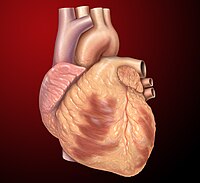
Photo from wikipedia
A 26-year-old asymptomatic female was referred to our hospital for a further evaluation of an abnormal shadow on chest X-ray. The first transthoracic echocardiography (TTE) showed the dilated right atrium… Click to show full abstract
A 26-year-old asymptomatic female was referred to our hospital for a further evaluation of an abnormal shadow on chest X-ray. The first transthoracic echocardiography (TTE) showed the dilated right atrium (RA) and ventricle (RV) (Fig. 1A, 1,2) without significant valvular disease. The estimated pulmonary to systemic flow ratio was 2.4, suggesting a significant increase in pulmonary blood flow. However, the first TTE could not reveal the pre-tricuspid left to right shunt disease. Contrast-enhanced computed tomography (CT) (Fig. 1B, 1–4) showed a superior sinus-venosus atrial septal defect (ASD) (white arrow) complicated by partial anomalous pulmonary venous connection (PAPVC) where the upper right (red arrow) and lower (yellow arrow) pulmonary veins were connected to the superior vena cava (SVC) and to the RA. We performed a second TTE with a more complete understanding of the anatomical relationship identified by the CT. An ASD, with a diameter of approximately 7 mm, was observed around the ceiling of the atrial septum. When the probe was gently tilted to the left heart system from the RV inflow view projected at the apical long-axis view (Fig. 1C1, 2, 3, Movie Clip A, B), we showed the superior sinus-venosus ASD (C-1, white arrow) and the upper (C-2, red arrow) and lower (C-3, yellow arrow) right pulmonary veins connected separately to the SVC and to the RA, respectively. She successfully underwent surgical intracardiac repair. Intraoperative findings revealed that the upper right pulmonary vein returned to the vicinity of the junction between the SVC and the RA. RV and RA volume overload without prominent ASD in TTE may be the only clue to detect PAPVC. Turner et al. reported that the repeated TTE could visualize neither ASD nor PAPVC; however, CT scanning clearly showed a sinusvenosus ASD complicated by PAPVC [1]. We identified a sinus-venosus ASD complicated by PAPVC at the modified RV inflow view. Sinus-venosus ASD may also be visualized in the bicaval view in the right thoracic or subcostal approach. In this case, it was impossible because the patient was obese. Prior study, however, has indicated that TTE even if with such approach was able to detect only 44% of sinusvenosus ASD [2]. We could identify not only the superior sinus-venosus ASD, but also PAPVC in a repeated TTE. Echocardiography including anatomical information from other cardiac imaging modalities might be relatively easier to visualize and evaluate more accurately compared to TTE alone, particularly for rare congenital heart disease. Electronic supplementary material The online version of this article (https ://doi.org/10.1007/s1257 4-020-00488 -4) contains supplementary material, which is available to authorized users.
Journal Title: Journal of Echocardiography
Year Published: 2020
Link to full text (if available)
Share on Social Media: Sign Up to like & get
recommendations!